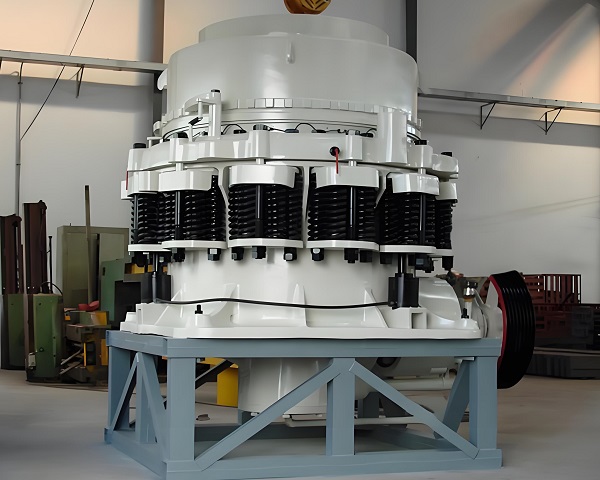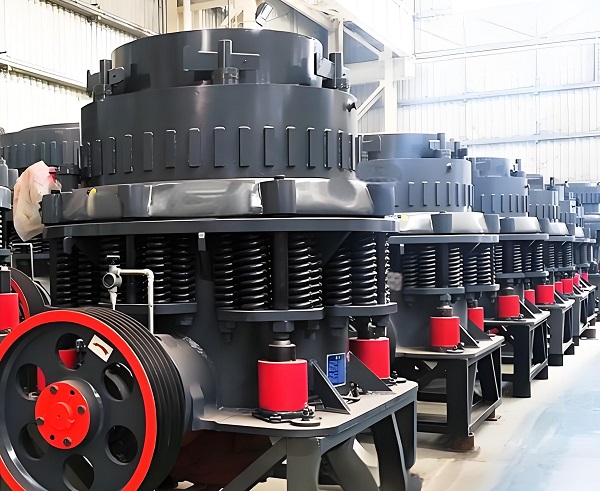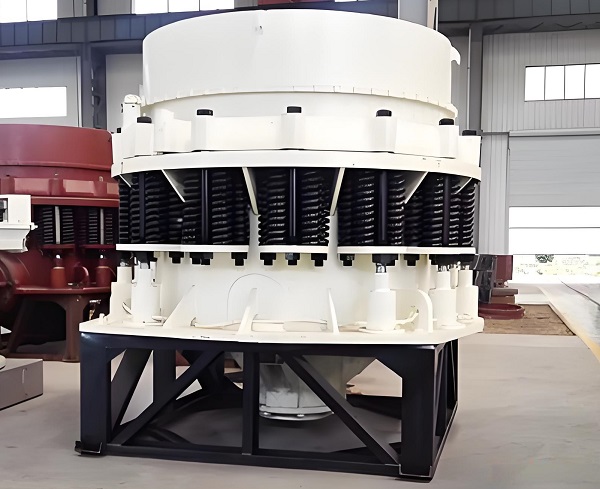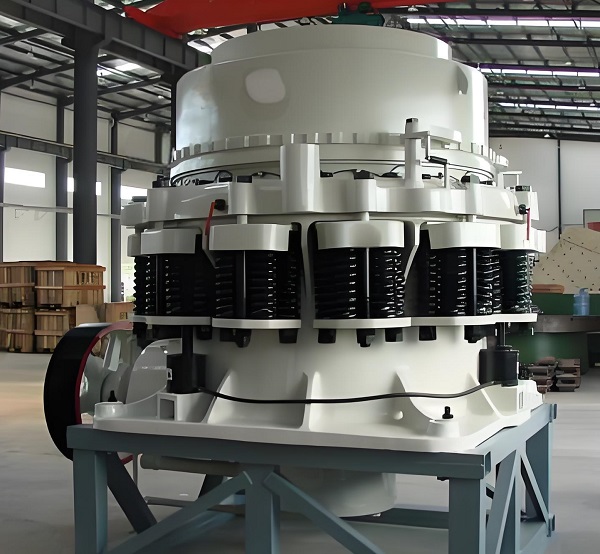In heavy-duty crushing applications such as mining and building materials production, spring cone crushers, thanks to their unique structural design, hold a central position. Their core technology, a "spring safety system + laminated crushing principle," addresses the pain points of traditional crushing equipment, often caused by foreign matter jamming, while also producing high-quality granular materials. From structural characteristics to performance advantages, from applicable areas to upgrade options, the technical value of this equipment permeates the entire raw material processing chain. This article systematically analyzes the dual-core structure, four major performance advantages, and diverse application scenarios of spring cone crushers. By leveraging case data and mining technical highlights, it provides a reference for industry model selection and upgrades.
Core Structural Features: Design Logic Based on the Spring System

1. "Crushing Chamber + Spring Safety" Dual-Core Structure
The spring cone crusher, with its core design featuring "eccentric shaft rotary crushing + spring safety protection," consists of a fixed cone, a moving cone, a spring system, and a transmission mechanism. The crushing chamber formed by the fixed cone and the moving cone features a layered design, tapering from the upper feed opening to the lower discharge opening. This adapts to the varying needs of coarse, medium, and fine crushing. For example, the coarse crushing chamber can accommodate feed sizes of 120-300mm, while the fine crushing chamber discharge size can be controlled within a range of 5-25mm.
The spring system is its hallmark, with 8-16 spring groups evenly distributed along the upper circumference of the equipment, connecting the fixed cone to the frame. This system serves both as a buffer and a safety device. During normal crushing, it provides preload, enhancing chamber stability. When uncrushable objects such as iron blocks enter, the springs compress, causing the fixed cone to move upward, widening the discharge opening and allowing foreign objects to escape, preventing equipment jamming. Data from a stone quarry in Henan Province shows that models equipped with spring safety devices have reduced the failure rate due to foreign object jamming from 15% to 2%, and the equipment's continuous operating time has been extended to over 20 hours.
2. Precise Adaptation of the Transmission and Adjustment Mechanisms
The transmission system utilizes a "motor + V-belt + eccentric shaft" configuration. The motor drives the eccentric shaft via the V-belt, which in turn drives the moving cone in a oscillating motion, achieving material extrusion and shearing crushing. This transmission method offers a simple structure and high power transmission efficiency, with transmission losses of only 5%-8%, a 10 percentage point reduction compared to hydraulic transmission models.
The discharge size adjustment mechanism is flexible, varying the crushing chamber gap by adjusting the vertical position of the fixed cone. A dial allows precise control of the discharge size with an adjustment accuracy of 1mm. Through fine adjustment, a metal ore concentrator in Yunnan has achieved a stable crushed ore particle size of 10±1mm, improving subsequent grinding efficiency by 22%. Some high-end models are equipped with a hydraulic adjustment device, reducing adjustment time from 30 minutes with manual adjustment to 5 minutes, making them suitable for frequent material changes.
3. Reliable Design of the Sealing and Lubrication Systems
To address the harsh working conditions of mining and stone processing, the equipment utilizes multiple seals and forced lubrication. The connection between the cone and the frame utilizes a "labyrinth seal + dust seal" combination, effectively preventing dust from entering the internal mechanism and achieving a seal life of over 8,000 hours. The lubrication system utilizes forced circulation of thin oil, with an oil pump delivering lubricating oil to key components such as the eccentric shaft and bearings. Oil temperature and pressure monitoring devices automatically shut down the machine when the oil temperature exceeds 65°C or the oil pressure is abnormal, preventing damage from dry friction.
A spring cone crusher at an open-pit coal mine in Inner Mongolia, operating in an environment with dust concentrations reaching 50mg/m³, has extended the bearing life of traditional models from 6 months to 12 months thanks to this seal and lubrication system, reducing equipment failure rate by 60%.
Key Performance Advantages: Core Value in Adapting to Heavy-Duty Crushing Scenarios

1. High Crushing Efficiency and Stable Processing Capacity
Utilizing the "laminated crushing" principle, the spring cone crusher undergoes multiple compression and grinding cycles within the crushing chamber, achieving crushing efficiency far exceeding that of a jaw crusher. Mainstream models offer throughput capacities of 50-1500 tons/hour. For example, the PYB2200 coarse crusher boasts a capacity of 800-1200 tons/hour, suitable for large-scale stone production lines. The PYD1750 fine crusher, with a capacity of 100-300 tons/hour, meets medium and fine crushing needs.
The stability of their processing capacity is particularly outstanding. A spring system cushions material fluctuations, allowing the equipment to maintain stable output even when feed rate fluctuates within ±20% of the rated load. After adopting a spring-loaded cone crusher in a limestone crushing line at a Shandong building materials factory, fluctuations in hourly throughput were reduced from 15% to 5%, resulting in a more balanced load on the subsequent screening system.
2. Excellent product particle shape and strong sorting adaptability.
The laminated crushing principle results in a more uniform particle shape after crushing, with a cubic content exceeding 70% and a flake content below 15%, far superior to the flake content of jaw crushers (over 30%). This high-quality particle shape is highly advantageous in the construction aggregate industry. A concrete mixing plant in Shanghai uses this equipment to crush limestone aggregate, resulting in a 10% increase in concrete strength compared to traditional aggregates and a 5% reduction in cement usage.
In mineral processing, a uniform particle shape improves subsequent sorting efficiency. Data from a copper ore processing plant in Jiangxi Province shows that ore crushed with a spring cone crusher has achieved a 35% improvement in particle size uniformity, increased flotation recovery from 82% to 88%, and increased concentrate grade by 0.5 percentage points.
3. Reliable operation and low maintenance costs.
The spring safety system significantly reduces the risk of equipment damage and minimizes downtime for maintenance. Statistics from a Hunan iron mine show that spring cone crushers require only 40 hours of downtime for maintenance annually, 60 hours less than hydraulic cone crushers, resulting in an equipment utilization rate exceeding 95%.
Long wear part life is another significant advantage. The movable and fixed cone liners are made of high-manganese steel or high-chromium cast iron. When crushing medium-hard materials such as limestone, the liners can reach 800-1200 hours, 50% longer than the liners of jaw crushers. Furthermore, the equipment features a streamlined structure, with only a few wearing parts, such as liners and seals, resulting in a long replacement cycle. This reduces annual operating and maintenance costs by 25%-30% compared to hydraulic models with the same processing capacity.
4. Wide adaptability and high operating tolerance
Spring cone crushers can process a wide range of materials with a compressive strength of ≤300 MPa, including limestone, granite, iron ore, and copper ore. They are widely used in mining, building stone, and metallurgical beneficiation. The crushing chamber can be adjusted to suit different material characteristics by replacing the liner: a deep-cavity coarse crushing liner is used for crushing hard materials (such as granite) to enhance crushing force; a shallow-cavity fine crushing liner is used for crushing medium-soft materials (such as limestone) to improve crushing efficiency.
It also offers superior operating tolerance compared to other models, maintaining stable operation in harsh environments such as high temperatures (above 40°C) and high dust concentrations. A spring cone crusher at a Gobi rock quarry in Xinjiang boasts an annual failure rate of only 3% in environments with a 30°C day-night temperature difference and high dust concentrations, demonstrating its exceptional environmental adaptability.
Application Areas and Value in Scenarios

1. Mining: Core Ore Pretreatment Equipment
In the mining of metal and non-metallic ores, spring cone crushers perform the core tasks of medium and fine crushing. In iron ore mining, this equipment crushes coarsely crushed ore to 20-50mm, providing the appropriate particle size for ball mills. After adopting this equipment at an iron mine in Hebei, ball mill throughput increased by 18% and grinding energy consumption per ton of ore decreased by 12kWh. In the non-metallic mineral sector, its uniform crushing characteristics prevent over-crushing when crushing materials such as gypsum and talc, improving yield. At a gypsum mine in Shandong, the yield increased from 85% to 92%.
2. Building Stone: The Mainstay of High-Quality Aggregate Production
As construction projects demand higher aggregate quality, spring cone crushers have become standard equipment for high-quality aggregate production lines. In highway aggregate production, the crushed basalt aggregate has a uniform particle shape, meeting the stringent standard of "needle-flake content ≤ 10%." Using this aggregate on a highway project in Henan Province has resulted in 100% compliance with the required compressive strength for the pavement. In commercial concrete, the continuous gradation of crushed limestone aggregate reduces cement usage and lowers concrete production costs.
3. Metallurgy and Chemical Industry: Material Purification and Pretreatment Equipment
In the processing of auxiliary raw materials in metallurgy, spring cone crushers are used to crush auxiliary materials such as coke and dolomite to a particle size that meets the requirements for blast furnace smelting. After adopting this equipment at a steel plant in Anshan, the utilization rate of auxiliary materials increased by 8%, and the blast furnace coke ratio decreased by 20kg/ton of iron. In the chemical industry, precise particle size control when crushing raw materials such as phosphate ore and potash ore can improve subsequent leaching efficiency. Data from a phosphate chemical company in Yunnan showed that when the ore particle size was controlled at 15mm, the phosphoric acid leaching rate increased by 5 percentage points.
Existing Limitations and Development Directions

Despite their significant advantages, spring cone crushers still have shortcomings: the discharge opening adjustment accuracy of the spring safety system is limited, making it difficult to meet the precise requirements of ultra-fine crushing (≤5mm). When processing sticky materials, the crushing chamber is prone to blockage, requiring frequent cleaning. To address these issues, the industry is promoting technological upgrades:
Intelligent Improvements: Integrating IoT sensors and AI algorithms monitors the crushing chamber load and particle shape in real time, automatically adjusting the discharge opening. A pilot model at one company has achieved a 90% particle shape qualification rate.
Structural Optimization: Developing a "spring + hydraulic" composite safety system balances safety reliability with precise adjustment.
Material Upgrades: Utilizing wear-resistant ceramic liners, the lifespan is extended to over 1,500 hours when crushing hard materials.
The spring cone crusher, with its core structural features of "spring safety + laminated crushing," demonstrates significant advantages in heavy-duty crushing, including high efficiency, strong reliability, and excellent particle shape. It has become an indispensable core equipment in the mining, building materials, and other fields. Although it has limitations in ultra-fine crushing and processing sticky materials, advancements in intelligent technology and material technology will further expand its application areas. Against the backdrop of the efficient utilization of mineral resources and accelerated infrastructure construction, spring cone crushers will continue to play a key role, providing solid support for improving quality and efficiency in the raw materials processing industry.
Save Time! Get A Detailed Quotation Quickly.
